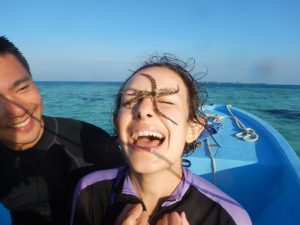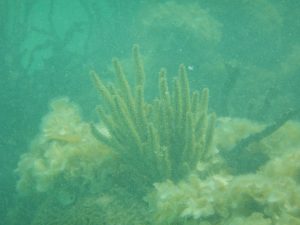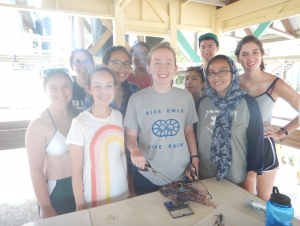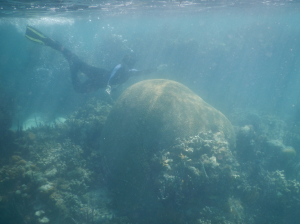Things are winding down here in Belize. It’s our last full day here and I can’t comprehend how quickly the time has passed.
This morning, we started out by dissecting lionfish that Scott has been finding and spearing these past few days at the reef. Lionfish are invasive species, meaning that they were unnaturally reduced to the area around here. Because this ecosystem didn’t evolve with lionfish in it, these guys don’t have any natural predators here, and the native fish don’t recognize lionfish as a threat. This means that lionfish can gorge themselves on helpless native species without fear of predation.
Because of all this, killing and eating lionfish is actually encouraged here! Even all the vegetarians on this trip tried the lionfish – they are detrimental to the environment, after all! We first took measurements of each specimen to contribute to a database about lionfish. In the individual that Claire and I dissected, we found a mostly undigested fish still in its stomach!
Scott made us some delicious ceviche using the lionfish after we finished the dissections. Made for a nice (and eco-friendly) snack!
After lunch, a few of us headed out for one last snorkel on these incredible patch reefs. Today was a great day for lobster sighting, as I spotted 5 large Caribbean spiny lobster hiding in caves in the reef. We also got the chance to watch the colorful ecosystem of the reef one last time before we head out tomorrow. And we finally spotted a starfish, a type of Echinoderm, in the sea grass. I hadn’t seen one yet out in the field, so I was super excited when Jessica spotted it on the way back! It was a cushion star, quite plump and with spiny orange skin. Its tube feet suctioned to my skin.
This afternoon was purely an afternoon of fun and relaxation, which was a strange but welcome change of pace. Apparently it’s an old tradition of TFBs past to travel to a nearby island, Southwest Caye, to hang out at the bar and enjoy the island. We spent a happy afternoon sitting on the dock, dancing to Belizean music with one of our marine safety officers, Rose, and exploring the island.
I was pretty skeptical at the beginning of this course about becoming comfortable with my classmates on the trip. But by now we’ve been the grossest and smelliest of our lives together, experienced nature at its best with each other, and picked ticks off of each other’s backs like gorillas. And later tonight, after we returned to Middle Caye, we had a short group meditation session led by Scott.
I guess it’s impossible to experience these things together without becoming good friends.
Today has been a bittersweet day, for sure. I can’t believe we’re leaving this place.


 Last sunset in Belize.
Last sunset in Belize.

 Juvenile long-spined sea urchin.
Juvenile long-spined sea urchin. Beautiful elkhorn coral specimen (scientific name Acropora palmata) that I found at the deeper patch reef.
Beautiful elkhorn coral specimen (scientific name Acropora palmata) that I found at the deeper patch reef. This picture is here just because I think it’s so cool – this is a mollusk commonly known as flamingo’s tongue! I found it at the reef crest.
This picture is here just because I think it’s so cool – this is a mollusk commonly known as flamingo’s tongue! I found it at the reef crest.















